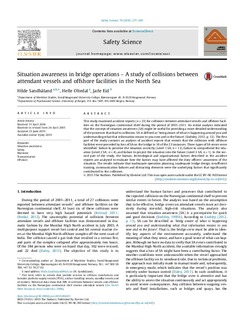| dc.contributor.author | Sandhåland, Hilde | |
| dc.contributor.author | Oltedal, Helle Asgjerd | |
| dc.contributor.author | Eid, Jarle | |
| dc.coverage.spatial | Norway, North Sea | nb_NO |
| dc.date.accessioned | 2015-12-22T10:32:53Z | |
| dc.date.accessioned | 2019-10-15T13:40:45Z | |
| dc.date.available | 2015-12-22T10:32:53Z | |
| dc.date.available | 2019-10-15T13:40:45Z | |
| dc.date.issued | 2015 | |
| dc.identifier.citation | Sandhåland, H., Oltedal, H., & Eid, J. (2015). Situation awareness in bridge operations: A study of collisions between attendant vessels and offshore facilities in the North Sea. Safety Science, 79, 277-285. | nb_NO |
| dc.identifier.issn | 0925-7535 | |
| dc.identifier.uri | http://hdl.handle.net/11250/2622311 | |
| dc.description.abstract | This study examined accident reports (n = 23) for collisions between attendant vessels and offshore facilities on the Norwegian continental shelf during the period of 2001–2011. An initial analysis indicated that the concept of situation awareness (SA) might be useful for providing a more detailed understanding of the processes that lead to collisions. SA is defined as ‘being aware of what is happening around you and understanding what that information means to you now and in the future’ (Endsley, 2012, p. 13). The first part of the study contains an analysis of accident reports that reveals that the collisions with offshore facilities were preceded by loss of SA on the bridge in 18 of the 23 instances. Three types of SA errors were identified: failure to perceive the situation correctly (Level 1 SA; n = 13), failure to comprehend the situation (Level 2 SA; n = 4), and failure to project the situation into the future (Level 3 SA; n = 1). In the second part of the study, the human, technological and organisational factors described in the accident reports are analysed to evaluate how the factors may have affected the duty officers‘ awareness of the situation. The results indicate that inadequate operation planning, inadequate bridge design, insufficient training, communication failures and distracting elements were the underlying factors that significantly contributed to the collisions. | nb_NO |
| dc.language.iso | eng | nb_NO |
| dc.publisher | Elsevier | nb_NO |
| dc.rights | Attribution-NonCommercial-NoDerivatives 4.0 Internasjonal | * |
| dc.rights.uri | http://creativecommons.org/licenses/by-nc-nd/4.0/deed.no | * |
| dc.subject | situation awareness | nb_NO |
| dc.subject | safety | nb_NO |
| dc.subject | maritime | nb_NO |
| dc.subject | transportation | nb_NO |
| dc.subject | offshore | nb_NO |
| dc.title | Situation awareness in bridge operations – A study of collisions between attendant vessels and offshore facilities in the North Sea | nb_NO |
| dc.type | Journal article | nb_NO |
| dc.date.updated | 2015-12-22T10:32:53Z | |
| dc.rights.holder | Copyright © 2015 The Authors. | nb_NO |
| dc.subject.nsi | VDP::Samfunnsvitenskap: 200::Psykologi: 260::Sosial- og arbeidspsykologi: 263 | nb_NO |
| dc.subject.nsi | VDP::Social sciences: 200::Psychology: 260::Social and occupational psychology: 263 | nb_NO |
| dc.source.pagenumber | 277-285 | nb_NO |
| dc.source.volume | 79 | nb_NO |
| dc.identifier.doi | 10.1016/j.ssci.2015.06.021 | |
| dc.identifier.cristin | 1259311 | |
| dc.relation.project | Norges forskningsråd: 210494 | nb_NO |

